
Background information
Thermomix, we need to talk again
by Luca Fontana

"Open the lid, take out the honey, everything's great." That would be nice. Without care and commitment, your bees will be dead after one season.
It's raining. The outside temperature is in the single-digit plus range. I'm not thrilled. Even less so the honey bees that I actually wanted to visit. Actually, because I won't get to see them today. It's too cold to open the free-standing magazines, their foster father André Zumsteg explains to me.
"I find it fascinating to see how a bee colony works. It's also a hobby for the whole family." He's known this since he was a little boy himself. Back then, he regularly went to the beehive with his grandad. His grandfather is a farmer in Fricktal in the canton of Aargau and keeps bees on the side. "His bees were quite keen to sting, which I often experienced first-hand," says André. After his grandfather died, André's mother and brother-in-law took care of the non-purebred Swissmix bees. "When my parents split up, my brother-in-law took over the bee colonies, which are still owned by my cousin today. So beekeeping has been part of our family history for generations."
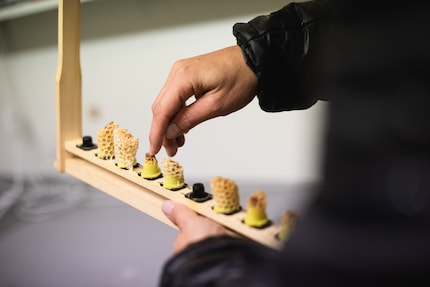
For years, André had nothing to do with bees, but last year he was hooked again. "I was looking for a balance to my work as a computer scientist, where I sit inside all day." Beekeeping seemed perfect to him, and not just because the whole family can get involved. "Bees are very sensitive. They sense bad moods and stress immediately, forcing you to slow down and be more balanced," says André. That's why he started a two-year beekeeping course last year and bought his first two bee colonies. The passion for beekeeping is written all over his face.
This passion led him to leave a comment under one of our articles. "I usually stay out of such discussions, but I couldn't help myself with this topic," he says. The article introduces the "B-Box", which tries to make you believe that anyone can easily keep bees on their balcony. "That simply doesn't work if you want to have your colony for more than one season." Beekeeping is an ambitious hobby that requires a lot of dedication and a willingness to learn." Above all, there is one big little enemy to keep an eye on: the Varroa mite. This was also brought into play by other Community members in the comments column.
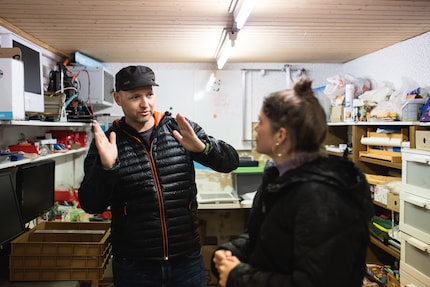
The parasite was introduced from Asia in 1984 and has since become the world's most important bee pest. So significant, in fact, that honey bees no longer survive in the wild in Switzerland and most other countries. This is because they cannot (yet) get rid of the mites without outside help. One way to keep the problem under control is to treat them with formic and oxalic acid. "I treat my bees three to four times a year. At the end of July, when the honey season is over, and in mid-October with formic acid to prevent reinfection. After each treatment I count the dead mites to check the success of the treatment. If necessary, I also spray the bees with oxalic acid in late autumn to reduce the mite pressure. I repeat this treatment at the end of December to get them through the winter in good health." Formic acid evaporates in the hive and kills the Varroa mites even in the capped brood cells, but can also harm the bees and the queen. Oxalic acid, on the other hand, is well tolerated by the bees and also activates their cleaning instinct, which can cause further parasites to fall off the bees. "If I don't carry out these treatments, my colonies will die sooner or later."
There are other reasons why André thinks it's important to get to grips with the hobby beforehand. "Beekeeping is an expensive passion because you need a lot of material. It's also time-consuming, depending on the season. Among other things, I have to check the colonies for varroa, make sure they don't swarm out because they're bored and monitor the queen offspring." Then there's the two-year beekeeping course and the usual membership of an association. And a good dose of patience. "Every beekeeper has a different opinion that they think is the only right one. So you have to find an approach that suits you personally. That takes a lot of time and tinkering." If you keep all this in mind, beekeeping is a wonderful activity.
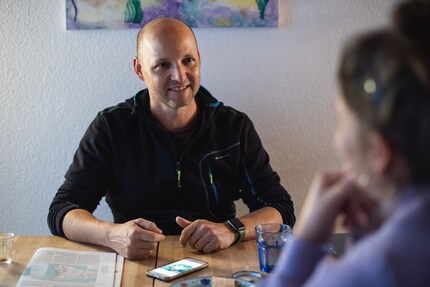
After a year of beekeeping, the number of colonies has risen from two to eight. "I got four from surplus swarms from other beekeepers and two from scratch." When swarming, the old queen vacates her daughter's throne and flies off with most of the worker bees to settle in a new place. The excursion usually ends at a tree or bush in the neighbourhood. Now beekeepers and professional bee catchers are needed. They collect the runaways and give them a new home. In the case of the new colonies, a friend's colony escaped. "I found it and caught it again. Whoever finds it, owns it." All the bees now live in magazines at the edge of the forest on a farmer's property. The name of each colony is also written on them. Cinderella, Mulan, Rapunzel etc. The pattern is clearly recognisable: main female Disney characters. Only one name tag is out of line. "You can't keep bees without paying homage to the most famous representative of the species. Maja."
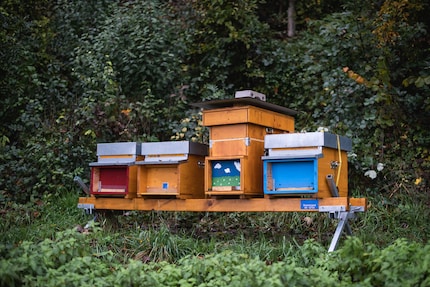
On the cold and wet way back from the bee magazines, we pass the local school. On the playground there is a stone fountain with a straight metal tap. "Bees need a permanent source of water and mine initially opted for the school fountain because the water only trickles lightly onto the stone in some places. Perfect for the little insects. Less perfect for the children." Bees wouldn't just sting on a whim, but the pupils are still afraid. That's why André built his own water source directly in front of the magazines. "It took a generation for my bees to understand this and stop flying to the well," he says. Like us humans, they seem to take a long time to get used to change.
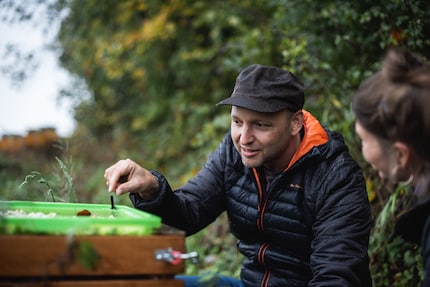
It's not just the bees that have realised that change can be good, but André too. "Unlike grandad's bees, mine are gentler and much less keen to sting," says André with a laugh. Nevertheless, he was stung around 30 times, which is just part of the job. The stings probably mainly came from his "arsehole colony", as he calls his rather choleric bees. In contrast to them are the "swimming trunks colonies", which take life very calmly. Nevertheless, he likes all his bees. And not just because they gave him honey in their first year. "Normally you can only expect some honey from the second year onwards, but I was able to harvest two kilos this summer," says André. Eight filled jars with his own branding have resulted for his own consumption. "Next year I expect to produce eight to ten kilos per batch, and 20 to 35 kilos the following year. Then I'd like to sell a few jars." That might just be enough to cover the investment. To make a living from beekeeping, you need at least 150 bee colonies. "Then you can make ends meet, you're not swimming in riches."
With all the time and money involved, I'm no longer surprised that a jar of Swiss honey costs around 12.50 francs in the shop and not 2.50 francs. Spending money on local honey is not only a good investment because it supports beekeepers, but also for your own health. "Honey from your region can help you desensitise yourself to hay fever. This is because there is pollen in the jar that does not trigger a reaction in this small dosage, but rather acclimatises your body to it."
Now it's time to savour the fruits of this hard work that I've heard so much about. André's wife seems to think so too and brings a small snack into the parlour. I immediately drizzle a piece of toast with the Aargau honey. The surface lustre doesn't break its promise.
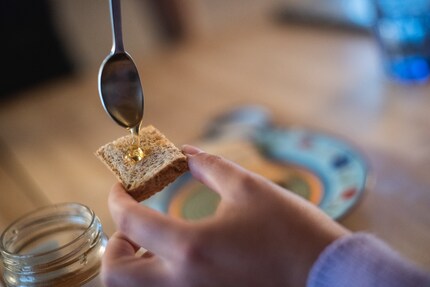
My life in a nutshell? On a quest to broaden my horizon. I love discovering and learning new skills and I see a chance to experience something new in everything – be it travelling, reading, cooking, movies or DIY.